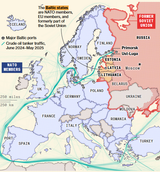Search Results
6/24/2025, 3:24:14 PM
>>508579861
2/?
The warnings come as NATO — under pressure from Trump — pushes members to raise defense spending to the highest levels in decades.
Denmark has said Russia could engage in a local war with a neighboring country within six months and pose a credible threat to one or more NATO countries within two years.
In such a scenario, Estonia, Latvia and Lithuania on NATO’s northeastern flank would be the most likely flashpoint. The three Baltic nations make up a small fraction of the European economy but strategically, they are critical.
As the only NATO members once directly administered by the Soviet Union, and the home to substantial Russian minority populations, they have a special place in Putin’s distorted historical imagination. They also have long borders with Russia and its satellite, Belarus. Any attack would quickly become a test of US willingness to defend NATO allies against Russia, the cornerstone on which the western alliance was built.
A war, even in its initial phase, would see many people killed and likely trigger a flood of refugees. It would also exact a heavy economic toll.
Bloomberg Economics estimates that the direct cost of destruction in the warzone, higher energy prices as supply from Russia is cut off, and a selloff in financial markets could cut global output by 1.3% or $1.5 trillion in the first year, almost as much as the impact of the full-scale invasion of Ukraine. The losses would be much greater if the conflict spilled into other European countries.
This article is based on modelling by Bloomberg Economics as well as interviews with senior government officials who spoke on condition of anonymity to share their views and private assessments frankly.
2/?
The warnings come as NATO — under pressure from Trump — pushes members to raise defense spending to the highest levels in decades.
Denmark has said Russia could engage in a local war with a neighboring country within six months and pose a credible threat to one or more NATO countries within two years.
In such a scenario, Estonia, Latvia and Lithuania on NATO’s northeastern flank would be the most likely flashpoint. The three Baltic nations make up a small fraction of the European economy but strategically, they are critical.
As the only NATO members once directly administered by the Soviet Union, and the home to substantial Russian minority populations, they have a special place in Putin’s distorted historical imagination. They also have long borders with Russia and its satellite, Belarus. Any attack would quickly become a test of US willingness to defend NATO allies against Russia, the cornerstone on which the western alliance was built.
A war, even in its initial phase, would see many people killed and likely trigger a flood of refugees. It would also exact a heavy economic toll.
Bloomberg Economics estimates that the direct cost of destruction in the warzone, higher energy prices as supply from Russia is cut off, and a selloff in financial markets could cut global output by 1.3% or $1.5 trillion in the first year, almost as much as the impact of the full-scale invasion of Ukraine. The losses would be much greater if the conflict spilled into other European countries.
This article is based on modelling by Bloomberg Economics as well as interviews with senior government officials who spoke on condition of anonymity to share their views and private assessments frankly.
Page 1
